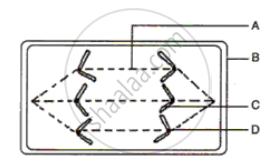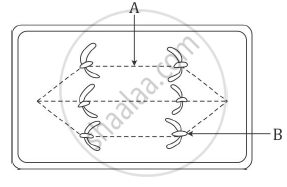Advertisements
Advertisements
प्रश्न
The diagram given alongside represents a stage in cell division.
Study the same and answer the questions that follow:

(i) Identify the stage of cell division.
(ii) Name the parts labeled A,B,C and D.
(iii) What is the unique feature observed in this stage?
(iv) Where does this type of cell division usually occur?
(v) How many daughter cells are formed from this type of cell division?
(vi) Is the dividing cell shown a plant or an animal cell?
Give a reason to support your answer.
उत्तर
(i) Anaphase in a plant cell
(ii) A - Spindle fibre
B - Cell wall
(iii) The homologous daughter chromatids or chromosomes begin to move towards opposite poles.
(iv) This type of cell division occurs usually in the somatic cells.
(v) Two daughter cells are formed from this type of cell division.
(vi) The dividing cell shown is a plant cell because of the presence of cell wall and the absence of centriole.
APPEARS IN
संबंधित प्रश्न
The diagram given below represents a certain stage of mitosis:

- Identify the stage of cell division.
- Name the parts labelled A and B.
- What is the unique feature observed in this stage?
- How many daughter cells are formed from this type of cell division?
Fill in the blank:
______ is the indirect cell division.
Explain the Term Cell Diakinesis
Name the Following
Nuclear envelope and nucleoli reappear in which stage.
Give Technical Terms
The stage in mitosis when the nucleolus starts disappearing.
Multiple Choice Question:
The nuclear membrane disappears in
The karyotype (set of chromosomes) shown below is taken from a dividing cell in a certain individual.
(i) Is the individual male or female? Explain your answer.
(ii) How would you expect
(a) a female cell and
(b) sperm cell to differ in chromosome composition?
Explain the following figure.

During Mitosis what is the position of chromatids in the anaphase?
